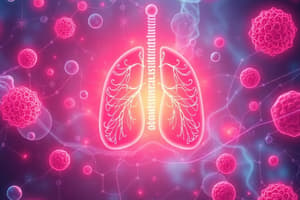Podcast
Questions and Answers
Where does glycolysis take place in a cell?
Where does glycolysis take place in a cell?
- Nucleus
- Endoplasmic Reticulum
- Cytoplasm (correct)
- Mitochondria
Which molecule is produced by the breakdown of glucose during aerobic respiration?
Which molecule is produced by the breakdown of glucose during aerobic respiration?
- Pyruvic acid (correct)
- Lactic acid
- Carbon dioxide
- ATP
What is the function of the citric acid cycle in aerobic respiration?
What is the function of the citric acid cycle in aerobic respiration?
- Break down glucose
- Produce lactic acid
- Pass pyruvic acids around a cycle (correct)
- Create ATP
Which organelle is responsible for the electron transport chain in aerobic respiration?
Which organelle is responsible for the electron transport chain in aerobic respiration?
What is the final product of the electron transport chain in aerobic respiration?
What is the final product of the electron transport chain in aerobic respiration?
Why is aerobic respiration more efficient than fermentation in generating ATP?
Why is aerobic respiration more efficient than fermentation in generating ATP?
Which step in aerobic respiration involves an enzyme called ATP synthase?
Which step in aerobic respiration involves an enzyme called ATP synthase?
What is the main purpose of aerobic respiration in organisms?
What is the main purpose of aerobic respiration in organisms?
How many moles of oxygen are required per two moles of glucose during aerobic respiration?
How many moles of oxygen are required per two moles of glucose during aerobic respiration?
What is the role of chemiosmosis in aerobic respiration?
What is the role of chemiosmosis in aerobic respiration?
Flashcards are hidden until you start studying
Study Notes
Respiration is a fundamental process of life, allowing organisms to obtain energy from nutrients. Aerobic respiration, also known as cellular respiration, occurs when oxygen is present and is typically carried out by cells in animals, plants, fungi, some bacteria, and most protists. In this process, glucose molecules break down into two lactate molecules using six moles of O2 per two moles of glucose, producing a total of four ATPs. This process releases carbon dioxide, which must be expelled through exhalation to avoid damaging tissues.
The primary steps involved in aerobic respiration are glycolysis, citric acid cycle, electron transport chain, and chemiosmosis. Glycolysis takes place within the cytoplasm of the cell, while the other three stages occur inside mitochondria. Specifically, glycolysis breaks down glucose and adds two phosphates to it, creating two pyruvic acids. The citric acid cycle involves passing these pyruvic acids around one circle made up of eight atoms, with each atom having its own specific job to do during the cycle. Finally, the electron transport chain uses the electrons released during the metabolic processes to create ATP, with the help of an enzyme called ATP synthase.
Overall, aerobic respiration has advantages over fermentation because it's more efficient at generating ATP, making available more energy from food sources than if they were used directly for growth. However, since it requires oxygen, aerobic respiration can only take place under certain conditions, such as being above a certain size. For example, yeast can ferment sugars even without oxygen, creating alcohol and CO2 gas. Therefore, knowing both fermentation and aerobic respiration allows scientists to determine what type of food source will best meet the needs of different species, whether it's sugar or flesh.
Studying That Suits You
Use AI to generate personalized quizzes and flashcards to suit your learning preferences.





